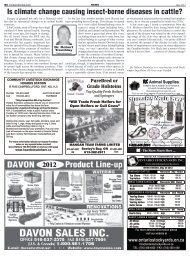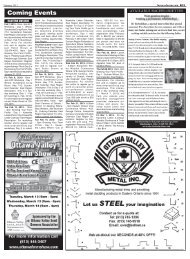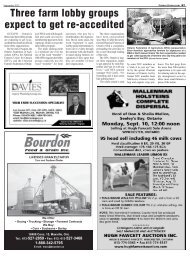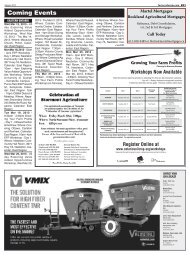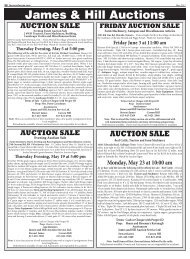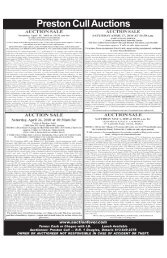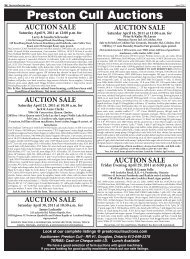Reducing the Risk of Fire on Your Farm - Ontario Ministry of ...
Reducing the Risk of Fire on Your Farm - Ontario Ministry of ...
Reducing the Risk of Fire on Your Farm - Ontario Ministry of ...
- No tags were found...
Create successful ePaper yourself
Turn your PDF publications into a flip-book with our unique Google optimized e-Paper software.
2.0 Preventative Maintenance to Reduce <str<strong>on</strong>g>the</str<strong>on</strong>g> <str<strong>on</strong>g>Risk</str<strong>on</strong>g> <str<strong>on</strong>g>of</str<strong>on</strong>g> <str<strong>on</strong>g>Fire</str<strong>on</strong>g>• Complete a yearly <str<strong>on</strong>g>the</str<strong>on</strong>g>rmographic inspecti<strong>on</strong> <str<strong>on</strong>g>of</str<strong>on</strong>g> <str<strong>on</strong>g>the</str<strong>on</strong>g> entire electrical system when <str<strong>on</strong>g>the</str<strong>on</strong>g> barn is at its peakelectrical demand (e.g. summer for swine and poultry). Many insurance companies now <str<strong>on</strong>g>of</str<strong>on</strong>g>fer this value addedservice for <str<strong>on</strong>g>the</str<strong>on</strong>g>ir policyholders. Make any necessary repairs to eliminate identified hot spots (Figure 2.3).Figure 2.3. Thermographic image <str<strong>on</strong>g>of</str<strong>on</strong>g> an electricaloutlet in a barn discovered during an annualinspecti<strong>on</strong>. Note <str<strong>on</strong>g>the</str<strong>on</strong>g> hotspots (red) at greaterthan 100 ºC (212 ºF).(Photo credit: R. Drysdale, <strong>Farm</strong> Mutual Reinsurance Plan)• The <strong>Ontario</strong> Electrical Safety Code permits <str<strong>on</strong>g>the</str<strong>on</strong>g> use <str<strong>on</strong>g>of</str<strong>on</strong>g> wiring for damp locati<strong>on</strong>s in farm buildings housinglivestock or poultry when <str<strong>on</strong>g>the</str<strong>on</strong>g> area has adequate ventilati<strong>on</strong>. For more informati<strong>on</strong> <strong>on</strong> ventilating livestockbuildings, see OMAFRA Publicati<strong>on</strong> 833, Ventilati<strong>on</strong> for Livestock and Poultry Facilities, www.service<strong>Ontario</strong>.ca• Replace older wiring that passes through <str<strong>on</strong>g>the</str<strong>on</strong>g> walls or o<str<strong>on</strong>g>the</str<strong>on</strong>g>r c<strong>on</strong>cealed building spaces with wiring installedin c<strong>on</strong>duit.• Have a licensed electrical c<strong>on</strong>tractor perform all electrical work within <str<strong>on</strong>g>the</str<strong>on</strong>g> building to ensure it is d<strong>on</strong>esafely and meets <str<strong>on</strong>g>the</str<strong>on</strong>g> requirements <str<strong>on</strong>g>of</str<strong>on</strong>g> <str<strong>on</strong>g>the</str<strong>on</strong>g> <strong>Ontario</strong> Electrical Safety Code. All electrical installati<strong>on</strong>s mustbe inspected by <str<strong>on</strong>g>the</str<strong>on</strong>g> Electrical Safety Authority (ESA).• Properly secure wiring enclosure covers to minimize <str<strong>on</strong>g>the</str<strong>on</strong>g> entry <str<strong>on</strong>g>of</str<strong>on</strong>g> corrosive gases and moisture.Replace damaged or deteriorated parts.• Do not store flammable and/or combustible material underneath or around <str<strong>on</strong>g>the</str<strong>on</strong>g> electrical panels.• Ensure a minimum <str<strong>on</strong>g>of</str<strong>on</strong>g> 1 m (3 ft) <str<strong>on</strong>g>of</str<strong>on</strong>g> clear access space in fr<strong>on</strong>t <str<strong>on</strong>g>of</str<strong>on</strong>g> each electrical panel.• Repair all damaged or malfuncti<strong>on</strong>ing fixtures or equipment as so<strong>on</strong> as practical.• Completely remove or physically disable all aband<strong>on</strong>ed or malfuncti<strong>on</strong>ing wiring within <str<strong>on</strong>g>the</str<strong>on</strong>g> barn. Removing<str<strong>on</strong>g>the</str<strong>on</strong>g> fuse or turning <str<strong>on</strong>g>of</str<strong>on</strong>g>f <str<strong>on</strong>g>the</str<strong>on</strong>g> breaker is not a good practice, or l<strong>on</strong>g-term soluti<strong>on</strong>, and can lead to dangeroussituati<strong>on</strong>s if <str<strong>on</strong>g>the</str<strong>on</strong>g> circuit is reactivated by accident.• Heat lamps are a comm<strong>on</strong> source <str<strong>on</strong>g>of</str<strong>on</strong>g> fire. When heat lamps are required, protect <str<strong>on</strong>g>the</str<strong>on</strong>g> immediate area withn<strong>on</strong>-combustible sheathing (c<strong>on</strong>crete board, c<strong>on</strong>crete, steel, tile, etc.). Keep <str<strong>on</strong>g>the</str<strong>on</strong>g> area around <str<strong>on</strong>g>the</str<strong>on</strong>g> heat lampclear <str<strong>on</strong>g>of</str<strong>on</strong>g> clutter or bedding materials that could catch fire. Only use heat lamps with <str<strong>on</strong>g>the</str<strong>on</strong>g> CSA or ULC label.Figures 2.4a and 2.4b show examples <str<strong>on</strong>g>of</str<strong>on</strong>g> incorrect and correct uses <str<strong>on</strong>g>of</str<strong>on</strong>g> heat lamps.7



